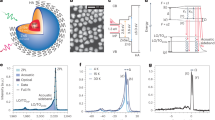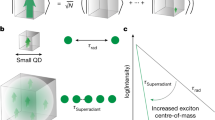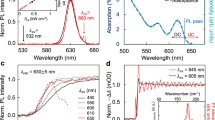Abstract
The application of colloidal semiconductor quantum dots as single-dot light sources still requires several challenges to be overcome. Recently, there has been considerable progress in suppressing intensity fluctuations (blinking) by encapsulating an emitting core in a thick protective shell. However, these nanostructures still show considerable fluctuations in both emission energy and linewidth. Here we demonstrate type-I core/shell heterostructures that overcome these deficiencies. They are made by combining wurtzite semiconductors with a large, directionally anisotropic lattice mismatch, which results in strong asymmetric compression of the emitting core. This modifies the structure of band-edge excitonic states and leads to accelerated radiative decay, reduced exciton–phonon interactions, and suppressed coupling to the fluctuating electrostatic environment. As a result, individual asymmetrically strained dots exhibit highly stable emission energy (<1 meV standard deviation) and a subthermal room-temperature linewidth (~20 meV), concurrent with nearly nonblinking behaviour, high emission quantum yields, and a widely tunable emission colour.
This is a preview of subscription content, access via your institution
Access options
Access Nature and 54 other Nature Portfolio journals
Get Nature+, our best-value online-access subscription
$29.99 / 30 days
cancel any time
Subscribe to this journal
Receive 12 print issues and online access
$259.00 per year
only $21.58 per issue
Buy this article
- Purchase on Springer Link
- Instant access to full article PDF
Prices may be subject to local taxes which are calculated during checkout





Similar content being viewed by others
Data availability
The data that support the findings of this study are available from the authors on reasonable request.
References
Greytak, A. B. et al. Alternating layer addition approach to CdSe/CdS core/shell quantum dots with near-unity quantum yield and high on-time fractions. Chem. Sci. 3, 2028–2034 (2012).
Jeong, B. G. et al. Colloidal spherical quantum wells with near-unity photoluminescence quantum yield and suppressed blinking. ACS Nano 10, 9297–9305 (2016).
Page, R. C. et al. Near-unity quantum yields from chloride treated CdTe colloidal quantum dots. Small 11, 1548–1554 (2015).
Kim, T.-H. et al. Full-colour quantum dot displays fabricated by transfer printing. Nat. Photon. 5, 176–182 (2011).
Colvin, V. L., Schlamp, M. C. & Alivisatos, A. P. Light-emitting diodes made from cadmium selenide nanocrystals and a semiconducting polymer. Nature 370, 354–357 (1994).
Kwak, J. et al. High-power genuine ultraviolet light-emitting diodes based on colloidal nanocrystal quantum dots. Nano Lett. 15, 3793–3799 (2015).
Klimov, V. I. et al. Optical gain and stimulated emission in nanocrystal quantum dots. Science 290, 314–317 (2000).
Lim, J., Park, Y.-S. & Klimov, V. I. Optical gain in colloidal quantum dots achieved with direct-current electrical pumping. Nat. Mater. 17, 42–48 (2018).
Wu, K., Li, H. & Klimov, V. I. Tandem luminescent solar concentrators based on engineered quantum dots. Nat. Photon. 12, 105–110 (2018).
Bronstein, N. D. et al. Quantum dot luminescent concentrator cavity exhibiting 30-fold concentration. ACS Photon. 2, 1576–1583 (2015).
Aharonovich, I., Englund, D. & Toth, M. Solid-state single-photon emitters. Nat. Photon. 10, 631–641 (2016).
Frasco, M. & Chaniotakis, N. Semiconductor quantum dots in chemical sensors and biosensors. Sensors 9, 7266–7286 (2009).
Medintz, I. L., Uyeda, H. T., Goldman, E. R. & Mattoussi, H. Quantum dot bioconjugates for imaging, labelling and sensing. Nat. Mater. 4, 435–446 (2005).
Jin, Z. & Hildebrandt, N. Semiconductor quantum dots for in vitro diagnostics and cellular imaging. Trends Biotechnol. 30, 394–403 (2012).
Mahler, B. et al. Towards non-blinking colloidal quantum dots. Nat. Mater. 7, 659–664 (2008).
Chen, Y. et al. ‘Giant’ multishell CdSe nanocrystal quantum dots with suppressed blinking. J. Am. Chem. Soc. 130, 5026–5027 (2008).
Chen, O. et al. Compact high-quality CdSe–CdS core–shell nanocrystals with narrow emission linewidths and suppressed blinking. Nat. Mater. 12, 445–451 (2013).
Qin, H. et al. Single-dot spectroscopy of zinc-blende CdSe/CdS core/shell nanocrystals: nonblinking and correlation with ensemble measurements. J. Am. Chem. Soc. 136, 179–187 (2014).
García-Santamaría, F. et al. Suppressed Auger recombination in ‘giant’ nanocrystals boosts optical gain performance. Nano Lett. 9, 3482–3488 (2009).
Nirmal, M. et al. Fluorescence intermittency in single cadmium selenide nanocrystals. Nature 383, 802–804 (1996).
Kuno, M., Fromm, D. P., Hamann, H. F., Gallagher, A. & Nesbitt, D. J. ‘On’/‘off’ fluorescence intermittency of single semiconductor quantum dots. J. Chem. Phys. 115, 1028–1040 (2001).
Efros, A. L. & Rosen, M. Random telegraph signal in the photoluminescence intensity of a single quantum dot. Phys. Rev. Lett. 78, 1110–1113 (1997).
Brovelli, S. et al. Nano-engineered electron–hole exchange interaction controls exciton dynamics in core–shell semiconductor nanocrystals. Nat. Commun. 2, 280 (2011).
Zakharov, O., Rubio, A., Blase, X., Cohen, M. L. & Louie, S. G. Quasiparticle band structures of six II–VI compounds: ZnS, ZnSe, ZnTe, CdS, CdSe, and CdTe. Phys. Rev. B 50, 10780–10787 (1994).
Dabbousi, B. O. et al. (CdSe)ZnS core−shell quantum dots: Synthesis and characterization of a size series of highly luminescent nanocrystallites. J. Phys. Chem. B 101, 9463–9475 (1997).
Tolbert, S. H. & Alivisatos, A. P. High-pressure structural transformations in semiconductor nanocrystals. Ann. Rev. Phys. Chem. 46, 595–626 (1995).
Fan, F. et al. Continuous-wave lasing in colloidal quantum dot solids enabled by facet-selective epitaxy. Nature 544, 75–79 (2017).
Norris, D. J., Efros, A. L., Rosen, M. & Bawendi, M. G. Size dependence of exciton fine structure in CdSe quantum dots. Phys. Rev. B 53, 16347–16354 (1996).
Karazhanov, S. Z. et al. Electronic structure and band parameters for ZnX (X = O, S, Se, Te). J. Cryst. Growth 287, 162–168 (2006).
Yang, C. S. et al. Compressive strain induced heavy hole and light hole splitting of Zn1−xCdxSe epilayers grown by molecular beam epitaxy. Mater. Chem. Phys. 78, 602–607 (2003).
Moise, T. S., Guido, L. J. & Barker, R. C. Strain-induced heavy-hole-to-light-hole energy splitting in (111)B pseudomorphic InyGa1−yAs quantum wells. Phys. Rev. B 47, 6758–6761 (1993).
Ren, S.-F., Xia, J.-B., Han, H.-X. & Wang, Z.-P. Electronic structure and optical properties of [(ZnSe)m(CdSe)n]N–ZnSe multiple quantum wells. Phys. Rev. B 50, 14416–14420 (1994).
Spinicelli, P. et al. Bright and grey states in CdSe–CdS nanocrystals exhibiting strongly reduced blinking. Phys. Rev. Lett. 102, 136801 (2009).
Fernee, M. J., Tamarat, P. & Lounis, B. Spectroscopy of single nanocrystals. Chem. Soc. Rev. 2014, 1311–1337 (2014).
Crooker, S. A., Barrick, T., Hollingsworth, J. A. & Klimov, V. I. Multiple temperature regimes of radiative decay in CdSe nanocrystal quantum dots: Intrinsic limits to the dark-exciton lifetime. Appl. Phys. Lett. 82, 2793–2795 (2003).
Gao, Y. & Peng, X. Photogenerated excitons in plain core CdSe nanocrystals with unity radiative decay in single channel: the effects of surface and ligands. J. Am. Chem. Soc. 137, 4230–4235 (2015).
Empedocles, S. A., Norris, D. J. & Bawendi, M. G. Photoluminescence spectroscopy of single CdSe nanocrystallite quantum dots. Phys. Rev. Lett. 77, 3873–3876 (1996).
Fernée, M. J. et al. Spontaneous spectral diffusion in CdSe quantum dots. J. Phys. Chem. Lett. 3, 1716–1720 (2012).
Kelley, A. M. Electron−phonon coupling in CdSe nanocrystals. J. Phys. Chem. Lett. 1, 1296–1300 (2010).
Takagahara, T. Electron–phonon interactions and excitonic dephasing in semiconductor nanocrystals. Phys. Rev. Lett. 71, 3577–3580 (1993).
Cragg, G. E. & Efros, A. L. Suppression of Auger processes in confined structures. Nano. Lett. 10, 313–317 (2010).
Tessier, M. D. et al. Spectroscopy of colloidal semiconductor core/shell nanoplatelets with high quantum yield. Nano. Lett. 13, 3321–3328 (2013).
Rainò, G. et al. Single cesium lead halide perovskite nanocrystals at low temperature: Fast single-photon emission, reduced blinking, and exciton fine structure. ACS Nano 10, 2485–2490 (2016).
Stanley, R. P., Hawdon, B. J., Hegarty, J., Feldman, R. D. & Austin, R. F. Room‐temperature exciton luminescence in II–VI quantum wells. Appl. Phys. Lett. 58, 2972–2974 (1991).
Fujiwara, K., Tsukada, N. & Nakayama, T. Observation of free excitons in room‐temperature photoluminescence of GaAs/AlGaAs single quantum wells. Appl. Phys. Lett. 53, 675–677 (1988).
Hines, M. A. & Guyot-Sionnest, P. Synthesis and characterization of strongly luminescing ZnS-capped CdSe nanocrystals. J. Phys. Chem. 100, 468–471 (1996).
Krauss, T. D. & Wise, F. W. Raman-scattering study of exciton–phonon coupling in PbS nanocrystals. Phys. Rev. B 55, 9860–9865 (1997).
Cui, J. et al. Evolution of the single-nanocrystal photoluminescence linewidth with size and shell: Implications for exciton–phonon coupling and the optimization of spectral linewidths. Nano. Lett. 16, 289–296 (2016).
Kelley, A. M. Electron–phonon coupling in CdSe nanocrystals from an atomistic phonon model. ACS Nano 5, 5254–5262 (2011).
Schmitt-Rink, S., Miller, D. A. B. & Chemla, D. S. Theory of the linear and nonlinear optical properties of semiconductor microcrystallites. Phys. Rev. B 35, 8113–8125 (1987).
Acknowledgements
V.I.K. and Y.-S.P. were supported by the Solar Photochemistry Program of the Chemical Sciences, Biosciences and Geosciences Division, Office of Basic Energy Sciences, Office of Science, US Department of Energy. J.L. acknowledges support by the Laboratory Directed Research and Development Program at Los Alamos National Laboratory.
Author information
Authors and Affiliations
Contributions
V.I.K. initiated the study. J.L. developed the synthesis of the asymmetrically strained QDs and fabricated QD samples for this work. Y.-S.P. conducted spectroscopic measurements and analysed the data. V.I.K. and Y.-S.P. prepared the manuscript with input from J.L.
Corresponding author
Ethics declarations
Competing interests
The authors declare no competing interests.
Additional information
Publisher’s note: Springer Nature remains neutral with regard to jurisdictional claims in published maps and institutional affiliations.
Electronic supplementary material
Supplementary Information
Supplementary Sections 1,2, Supplementary Figures 1–7, Supplementary Table 1, Supplementary References 1–10
Rights and permissions
About this article
Cite this article
Park, YS., Lim, J. & Klimov, V.I. Asymmetrically strained quantum dots with non-fluctuating single-dot emission spectra and subthermal room-temperature linewidths. Nature Mater 18, 249–255 (2019). https://doi.org/10.1038/s41563-018-0254-7
Received:
Accepted:
Published:
Issue Date:
DOI: https://doi.org/10.1038/s41563-018-0254-7
This article is cited by
-
Dipole–dipole-interaction-assisted self-assembly of quantum dots for highly efficient light-emitting diodes
Nature Photonics (2024)
-
Synthesis and Modulation of Low-Dimensional Transition Metal Chalcogenide Materials via Atomic Substitution
Nano-Micro Letters (2024)
-
Highly stable and pure single-photon emission with 250 ps optical coherence times in InP colloidal quantum dots
Nature Nanotechnology (2023)
-
Heteroepitaxial chemistry of zinc chalcogenides on InP nanocrystals for defect-free interfaces with atomic uniformity
Nature Communications (2023)
-
InP colloidal quantum dots for visible and near-infrared photonics
Nature Reviews Materials (2023)



